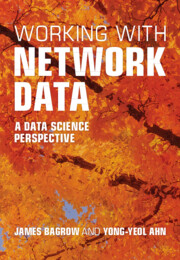Book contents
- Frontmatter
- Contents
- Preface
- Part I Background
- Chapter 1 A whirlwind tour of network science
- Chapter 2 Network data across fields
- Chapter 3 Data ethics
- Chapter 4 Primer
- Part II Applications, tools, and tasks
- Interlude — Good practices for scientific computing
- Part III Fundamentals
- Conclusion
- Bibliography
- Index
Chapter 4 - Primer
from Part I - Background
Published online by Cambridge University Press: aN Invalid Date NaN
- Frontmatter
- Contents
- Preface
- Part I Background
- Chapter 1 A whirlwind tour of network science
- Chapter 2 Network data across fields
- Chapter 3 Data ethics
- Chapter 4 Primer
- Part II Applications, tools, and tasks
- Interlude — Good practices for scientific computing
- Part III Fundamentals
- Conclusion
- Bibliography
- Index
Summary
Network science is a broadly interdisciplinary field, pulling from computer science, mathematics, statistics, and more. The data scientist working with networks thus needs a broad base of knowledge, as network data calls for—and is analyzed with—many computational and mathematical tools. One needs good working knowledge in programming, including data structures and algorithms to effectively analyze networks. In addition to graph theory, probability theory is the foundation for any statistical modeling and data analysis. Linear algebra provides another foundation for network analysis and modeling because matrices are often the most natural way to represent graphs. Although this book assumes that readers are familiar with the basics of these topics, here we review the computational and mathematical concepts and notation that will be used throughout the book. You can use this chapter as a starting point for catching up on the basics, or as reference while delving into the book.
Keywords
- Type
- Chapter
- Information
- Working with Network DataA Data Science Perspective, pp. 39 - 62Publisher: Cambridge University PressPrint publication year: 2024



